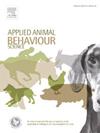Grooming behavior of rewilded Highland cattle in conservation grazing: Limited evidence of an influence of horsefly presence and temperature
IF 2
2区 农林科学
Q1 AGRICULTURE, DAIRY & ANIMAL SCIENCE
引用次数: 0
Abstract
Grooming behavior in domestic cattle serves various functions, including hygiene maintenance, social bonding, and stress alleviation. We examined the grooming patterns of rewilded Highland cattle, to describe their behavioral adaptations and responses to environmental factors in a conservation grazing system. We observed 21 Highland cattle in a French nature reserve from November 2020 to September 2021 using mixed focal and scan sampling methods, recording a total of 1225 grooming bouts. Throughout the observation period, cattle regularly performed grooming, consisting of self-grooming (83 %), tree-grooming (16 %), and social-grooming (1 %). We used linear and generalized mixed effect models to assess the effects of environmental factors such as the presence of horseflies, the Temperature-Humidity Index (THI), and habitat type. Our results showed that grooming behavior was influenced by habitat and group, while environmental stressors such as horseflies and elevated temperatures had only minor observed effects on grooming duration and frequency, and uncertainty was high. This limited response may be attributed to the relatively low density of horseflies in our study area and the opportunity of adaptive behaviors, such as wallowing, to manage heat and ectoparasites. By examining grooming behavior under near-natural conditions, this study provides a baseline for understanding behavioral patterns and adaptations in rewilded cattle, while also serving as a potential reference for identifying behavioral changes in domestic cattle and informing future management practices.
在保护放牧中重新放养的高原牛的梳理行为:马蝇存在和温度影响的有限证据
家畜的梳理行为具有多种功能,包括保持卫生、建立社会关系和减轻压力。我们研究了在保护性放牧系统中重新放养的高原牛的梳理模式,以描述它们的行为适应和对环境因素的反应。我们于2020年11月至2021年9月在法国自然保护区观察了21头高原牛,采用混合焦点和扫描采样方法,共记录了1225次梳理。在整个观察期间,牛定期进行梳理,包括自我梳理(83% %)、树上梳理(16% %)和社会梳理(1% %)。我们使用线性和广义混合效应模型来评估环境因素的影响,如马蝇的存在、温度-湿度指数(THI)和栖息地类型。结果表明,毛发梳理行为受栖息地和群体的影响,而环境压力因素(如马蝇和温度升高)对毛发梳理时间和频率的影响较小,且不确定性较高。这种有限的反应可能归因于我们研究区域的马蝇密度相对较低,以及适应行为的机会,例如打滚,以管理热量和体外寄生虫。通过研究在接近自然条件下梳理毛发的行为,本研究为理解野生牛的行为模式和适应性提供了基线,同时也为识别家养牛的行为变化提供了潜在的参考,并为未来的管理实践提供了信息。
本文章由计算机程序翻译,如有差异,请以英文原文为准。
求助全文
约1分钟内获得全文
求助全文
来源期刊

Applied Animal Behaviour Science
农林科学-行为科学
CiteScore
4.40
自引率
21.70%
发文量
191
审稿时长
18.1 weeks
期刊介绍:
This journal publishes relevant information on the behaviour of domesticated and utilized animals.
Topics covered include:
-Behaviour of farm, zoo and laboratory animals in relation to animal management and welfare
-Behaviour of companion animals in relation to behavioural problems, for example, in relation to the training of dogs for different purposes, in relation to behavioural problems
-Studies of the behaviour of wild animals when these studies are relevant from an applied perspective, for example in relation to wildlife management, pest management or nature conservation
-Methodological studies within relevant fields
The principal subjects are farm, companion and laboratory animals, including, of course, poultry. The journal also deals with the following animal subjects:
-Those involved in any farming system, e.g. deer, rabbits and fur-bearing animals
-Those in ANY form of confinement, e.g. zoos, safari parks and other forms of display
-Feral animals, and any animal species which impinge on farming operations, e.g. as causes of loss or damage
-Species used for hunting, recreation etc. may also be considered as acceptable subjects in some instances
-Laboratory animals, if the material relates to their behavioural requirements
 求助内容:
求助内容: 应助结果提醒方式:
应助结果提醒方式:


